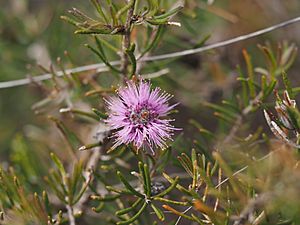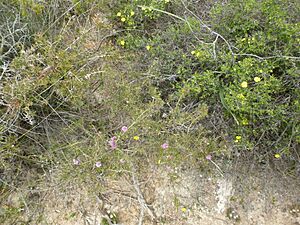Melaleuca tinkeri facts for kids
Quick facts for kids Melaleuca tinkeri |
|
|---|---|
 |
|
| M. tinkeri leaves and flowers | |
| Scientific classification | |
| Genus: |
Melaleuca
|
| Species: |
tinkeri
|
Melaleuca tinkeri is a special plant that belongs to the myrtle family, called Myrtaceae. It grows only in the south-west part of Western Australia, which means it is endemic to that area. This plant is one of the smallest melaleucas. You can spot it by its bumpy, hairy leaves, its pretty pink flowers that bloom in late winter and spring, and its round clusters of fruit.
Contents
What Does Melaleuca Tinkeri Look Like?
Melaleuca tinkeri is usually a small shrub, rarely growing taller than about 1 meter (3 feet).
Leaves and Stems
Its leaves grow one after another along the stem. They are about 8 to 34 millimeters (0.3 to 1.3 inches) long and very narrow, like a line or a thin egg shape. When the leaves are young, they feel soft and silky because they are covered in fine hairs. The plant's oil glands are raised, which makes the leaves look a bit bumpy or "warty."
Flowers and Fruit
The flowers of Melaleuca tinkeri are pink or purple. They grow in round clusters at the ends of branches. Even after the flowers bloom, the branches keep growing! Sometimes, flowers also appear where the leaves meet the stem.
Each flower cluster can be up to 17 millimeters (0.7 inches) wide. Inside, there are 4 to 12 groups of flowers, with three flowers in each group. The petals are small, about 1 to 1.5 millimeters (0.04 to 0.06 inches) long, and they fall off as the flower gets older. The outside of the flower cup is hairy. Each flower has five groups of stamens (the parts that hold pollen), with 3 to 6 stamens in each group.
Melaleuca tinkeri flowers from July to October. After the flowers, the plant grows woody fruits called capsules. These fruits are small, about 2.5 to 3.0 millimeters (0.1 inches) long, and they are packed tightly together in round or oval clusters.

Where Does Melaleuca Tinkeri Grow?
This melaleuca plant is found in specific areas of Western Australia, including the Nandanooka and Lesueur National Park regions. It likes to grow in shallow, sandy soil that has small stones, often over a type of rock called laterite or granite.
Is Melaleuca Tinkeri Protected?
The Government of Western Australia's Department of Parks and Wildlife has looked at Melaleuca tinkeri. They have listed it as "not threatened," which means it is not currently in danger of disappearing.
Images for kids


